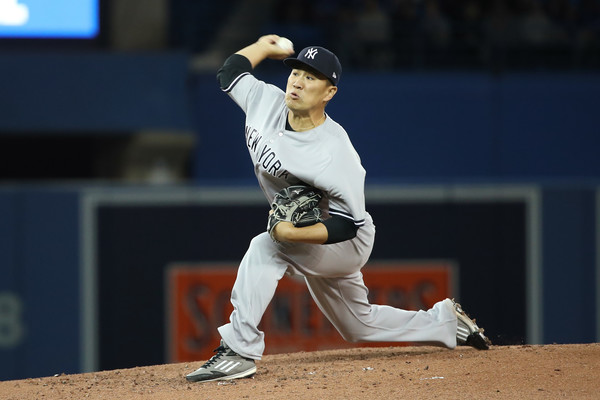
2018’s opening series against the Blue Jays has been nothing short of eventful. Giancarlo Stanton belted two homers in his Yankee debut. Aaron Hicks sustained an injury and was put on the DL. Two games later, his replacement–Billy McKinney–is heading there, too. Aaron Judge played center field. Adam Warren got hit with a comebacker. Dellin Betances had a hiccupy game. Potentially lost in all of that are the performances of two of the three Yankee starters in the series thus far, Luis Severino and Masahiro Tanaka.
Combined, the two allowed just one run in 11.2 innings on just four hits, three walks (all from Severino), while collecting 15 strikeouts. Both pitchers looked dominant for the majority of their starts and Tanaka ended his outing after retiring 13 straight batters. We could probably quibble with the relatively quick hooks Aaron Boone had with them, but this early in the year, I’m okay with it. Aside from results, Sevy and Masa had something else in common: how they attacked a mostly right-handed Blue Jay lineup.
In 2017, Luis Severino became a true three-pitch pitcher as he mixed in his changeup with more frequency and had great success with it. Throughout his career, Masahiro Tanaka has used multiple pitches as out pitches, but has generally leaned on his splitter. Both a changeup and a splitter, though, are not necessarily as effective against same-handed batters, so both pitchers relied on something more traditional in a R/R matchup: the slider.
Between the two of them, Severino (34) and Tanaka (31), threw 65 sliders to the Jays’ righties. Those sliders induced 37 swings from the hitters, who whiffed 16 times out of the 37. Only three of the sliders to righties were put into play–all from Tanaka–and none of them led to a hit.
Severino did a great job locating his slider down and away to righties, as well as down and in. Tanaka did as well, though he focused mainly on the ‘low and away’ part of the equation. If there were a textbook about pitching, these two performances would be in the ‘how to use sliders against righties’ chapter. Both executed nearly flawlessly against same-handed batters and the results show it.
Going forward, I’d expect both pitchers to use this strategy over and over again when they face heavily right handed lineups like Toronto’s. They’ll need to be wary, though, of still keeping their other out pitches sharp for when they face lefty-heavy or more balanced lineups. Given the talent level of these two, that shouldn’t be much of a problem.
Leave a Reply
You must be logged in to post a comment.